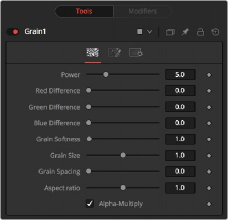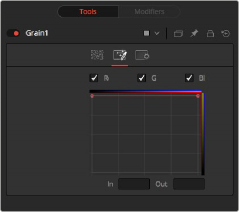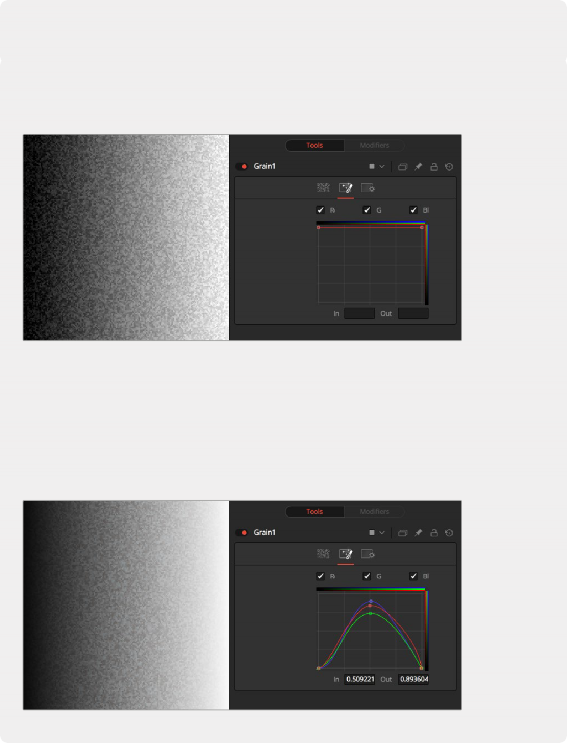
< Previous | Contents | Next >

The Grain node
Grain Node Introduction
The Grain node offers an older film grain emulation than the more modern and accurate Film Grain node. The Grain node is still provided to allow older compositions to load and render, but in almost every case, it is better to use the Film Grain node.
Input
There are two Inputs on the Grain node: one for the 2D image and one for the effects mask.
— Input: The orange input is used for the primary 2D image that gets the grain applied.
— Effect Mask: The blue input is for a mask shape created by polylines, basic primitive shapes, paint strokes, or bitmaps from other tools. Connecting a mask to this input limits the grain to be within the pixels of the mask. An effects mask is applied to the tool after the tool is processed.
Basic Node Setup
The Grain node is commonly placed before a MediaOut node in DaVinci Resolve, or before a Saver node in Fusion Studio. It adds back grain previously removed in a composite.

A Grain node used to add grain back for a more realistic composite
![]()
Inspector

Grain controls
Controls Tab
The Controls tab includes all the parameters for modifying the appearance of the grain.
This slider determines the strength of the grain. A higher value increases visibility, making the grain more prevalent.
Separate Red, Green, and Blue sliders are used to modify the strength of the effect on a per channel basis.
This slider controls the blurriness or fuzziness of the grain. Smaller values cause the grain to be more sharp or coarse.
This slider determines the size of the grain particles. Higher values increase the grain size.
This slider determines the density or amount of grain per area. Higher values cause the grain to appear more spaced out.
This slider adjusts the aspect of the grain so that it can be matched with anamorphic images.
When enabled, this checkbox multiplies the image by the Alpha, clearing the black areas of any grain effect.

![]()
Grain Spread controls
Spread Tab
The Spread tab uses curves for the red, green, and blue channels to control the amount of grain over each channel’s tonal range.
The red, green, and blue checkboxes enable each channel’s custom curve, allowing you to control how much grain appears in each channel. To mimic usual film responses, more grain would appear in the blue channel than the red, and the green channel would receive the least. Right-clicking in the spline area displays a contextual menu containing options related to modifying spline curves.
For more information on the LUT Editor’s controls see Chapter 45, “LUT Nodes,” in the Fusion Reference Manual.
This control provides direct editing of points on the curve by setting In/Out point values.

Examples
In the default setting, the grain is applied evenly to the entire image, as shown here. However, film often shows a different amount of grain in the blacks, mids, and whites.
Examples
In the default setting, the grain is applied evenly to the entire image, as shown here. However, film often shows a different amount of grain in the blacks, mids, and whites.
Examples
In the default setting, the grain is applied evenly to the entire image, as shown here. However, film often shows a different amount of grain in the blacks, mids, and whites.
Setting a bell shape is often a good starting point to create a more realistic-looking grain. Here we have a non-uniform distribution with different amounts of grain in the red, green, and blue channels.
In both examples, the grain’s power has been exaggerated to show the effect a bit better.
Setting a bell shape is often a good starting point to create a more realistic-looking grain. Here we have a non-uniform distribution with different amounts of grain in the red, green, and blue channels.
In both examples, the grain’s power has been exaggerated to show the effect a bit better.
Setting a bell shape is often a good starting point to create a more realistic-looking grain. Here we have a non-uniform distribution with different amounts of grain in the red, green, and blue channels.
In both examples, the grain’s power has been exaggerated to show the effect a bit better.
![]()
Common Controls Setting Tab
The Settings tab controls are common to all Film nodes, so their descriptions can be found in “The Common Controls” section at the end of this chapter.